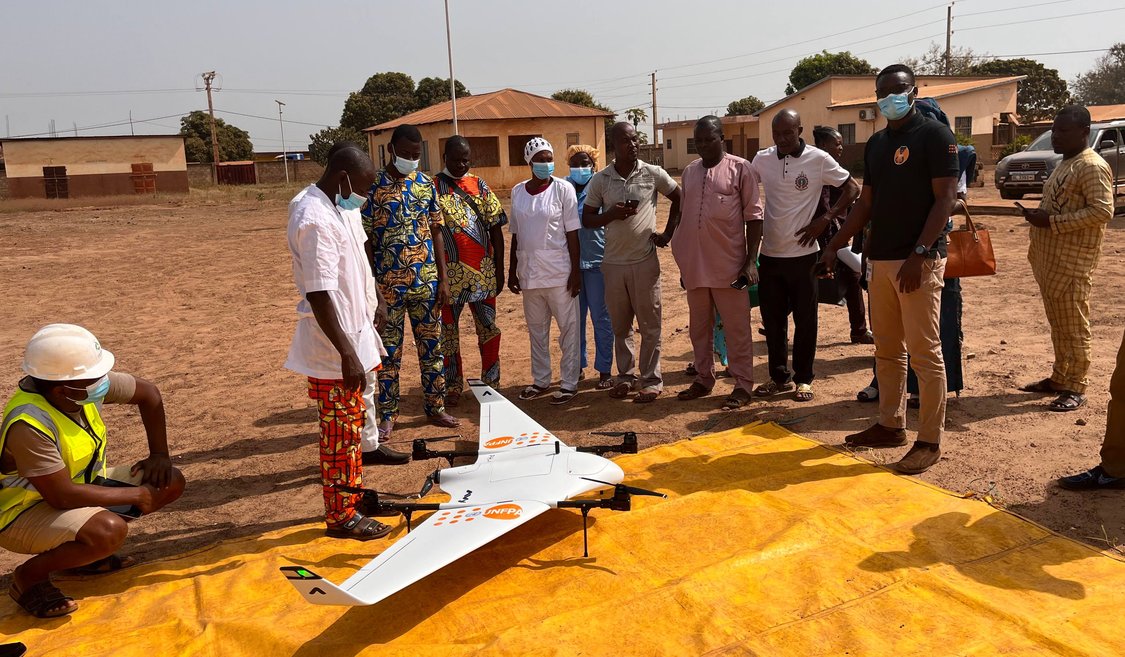
The last mile challenge in the Atacora region
Limited access to healthcare products, especially blood bags during childbirth is a severe problem in the Atacora region of Benin. According to the UNFPA, 397/100.000 live births in Benin cause maternal morbidity. More specifically in the Atacora region, we found that there are 180+ childbirth complications per month that need to be addressed with access to blood products. Reducing maternal and neonatal morbidity and mortality is a complex challenge that is dependent on a wide range of factors.
The gap between demand and supply of medical goods is significant in the Atacora region. Blood products are available in four designated storage centres of the region: Natitingou, Kouandé, Kérou & Tanguiéta, while most patients live in rural areas surrounding these. Moreover, rural medical facilities often lack the means to supply and store blood products, and refer patients to the central storage points.
Stock-outs are a challenge too, blood products are often not available, which means that patients are once again referred to the capital of the region: Natitingou. Warehouses with maternal healthcare products also face stock-outs on a regular basis. In the whole region, products like liquid paracetamol are of limited supply and many other life-saving means are out of stock.
To ensure the continuity of maternal, newborn and child health services, patients often move around different facilities to access the needed healthcare. In this race during child births, the mobilisation of patients, medical staff and products is key. This mobility-based access to healthcare is further limited due to lack of infrastructure and poor road conditions. When one drives with a car, a trip from Péhunko to Natitingou (78km, dirt road) takes 130 minutes, meaning that supply often comes too late for the patients in need of emergency healthcare.
In Benin, there are many regions that are quite isolated, particularly in certain periods of the year. In Firou, for example, there’s a small bridge that connects Firou to other communities, and during the rainy season the water levels rise and completely cut off Firou from other villages. But with a drone we can reach the maternity ward there. Until now, if it rained, the hospital was cut off and patients weren’t able to get the care they needed.”

Bridging the gap with an Atacora Drone Network
There is an urgent need to improve the accessibility to healthcare for remote areas in the Atacora region - especially for emergency situations. In collaboration with the Benin Ministry of Health, this proof of concept was initiated by the UNFPA Bénin, with the technical assistance of Global Partners (a local drone services company) and Benin Flying Labs, to tackle these healthcare challenges with the use of medical drone networks. The project initially started working with a quadcopter drone, but due to limitations regarding range, autonomy and payload capacity, Avy was brought into the second phase of the project to demonstrate the feasibility of the Avy Aera drone and the potential benefits for the targeted healthcare facilities.
The Atacora Drone Network aims to deliver emergency obstetric and newborn care products, such as blood bags, oxytocin and liquid paracetamol. Having such a drone delivery service in place would minimise risk and increase predictability, a welcome feature for any medical practitioner dealing with cases where time is critical and medical supplies are essential.
Without drones, if we run out of supplies, we have to quickly evacuate the patient to the nearest health centre in Kérou, which takes a long time. And it means that many may die while they are being transported to the hospital.

Successful completion of phase II
During phase II of the project, the Avy team on the ground worked closely with UNFPA Benin and Global Partners. During this phase it was important to mobilise multi-sectoral stakeholders around the use of drones like local health teams, the Civil Aviation Authority and above all, local communities. Community sensitisation was done prior to the project by the local UNFPA team through focus groups with 2 of the local communities.
Phase II included safety and feasibility testing of the Avy Aera drone and was critical when exploring stakeholder acceptance as well as studying the potential costs and benefits of introducing drones in the region. The goal was to demonstrate the different use cases are sufficiently promising to justify further investment.
Working with Avy was a great experience. The team were open-minded and ready to share, which allowed us to reach solution-based outcomes in the field of public health. This really fosters our desire to provide more for the rural population that fights so much everyday for living. We would be glad to have more of those moments we shared contributing to rural development based on technology.
Outcomes
- Total flights flown - 12
- Maximum distance flown - 42km
- Max speed - 23 m/s
- Total km flown - 229km
- Transported - 655g liquid paracetamol, 320g blood samples, 350g Covid-19 tests
TRANSPORT TIME - CAR VS. DRONE
- Natitingou - Kouandé - 37 mins vs. 85 mins → 56% faster
- Kouandé - Péhunco - 26 mins vs. 55 mins → 52% faster
Providing more direct routes and higher average speeds, drones are 2x faster when compared to road based transportation. The frequency, punctuality and accessibility of aerial transportation could reduce pathology waiting times by 35-67% per sample. Moreover, it was found that the network could become cheaper per emergency flight, when the assets and people employed were utilised to a maximum. An opportunity to add products on the flight back from facilities to the hub of the network (e.g. laboratory samples) would increase the usage further beyond the scope of emergency deliveries and reduce the costs per case.
